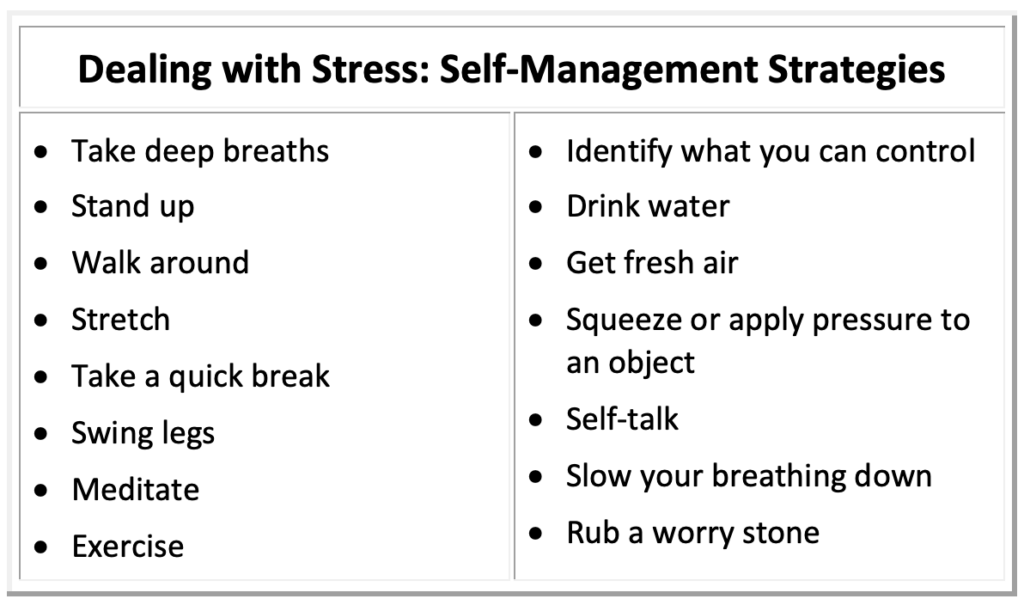Make Stress-Management a Priority: Tips for Teachers and School Leaders

“I’m on the edge of a breakdown. I’m pouring everything I have into my students, and it doesn’t seem to be enough. My principal keeps telling me I need to take care of myself, but she never gives me time to do it!”
I have heard some version of this lament frequently over the past few months. Just as teachers need to create safe and supportive environments so that students can thrive, so too, school leaders need to create safe environments for teachers. In fact, I would argue that this is one of school leaders’ most important roles.
At the same time, teachers can’t just wait around for someone else to take care of their stress. Not only might this never happen, but by waiting for someone else to solve problems, teachers might increase their feelings of helplessness and lack of agency–which can actually increase stress.
This article offers tons of practical ideas for how to help reduce teacher’s stress. Before we go there, let’s take a brief look why this is so important.
Stressed-Out Teachers Stress Out Students
A few years ago, researchers in British Columbia conducted a fascinating study. They had 400 elementary school students spit into test tubes. (Gross, right?) They measured students’ levels of cortisol (a stress hormone). They then compared those results with teachers’ self-assessment of their own levels of workplace stress. You probably won’t be surprised to find that teachers who reported higher levels of stress had students with significantly higher levels of cortisol in their saliva. What did researchers conclude? Stressed-out teachers stress out students.
This is important at any time, since there are such clear and compelling links between students’ emotions and their learning. It is especially important right now—as we’re all in the midst of the COVID-19 pandemic. With so much uncertainty and so much at stake, we should expect that teachers will experience some pretty significant stress.
Stressed-out teachers stress out students. Teacher wellness must be a priority if we want students to learn. #teacherwellnessmatters
Mike Anderson Tweet
Be Proactive About Stress-Management
It can feel selfish to make our own wellness a priority. We’re teachers because we’re care-givers, after all. We get our energy from helping others. However, if we don’t take good care of ourselves, we won’t be in a position to help students and parents who need us to be our best selves. We must get into healthy habits that will give us the mental, physical, and emotional reserves needed to be welcoming, calm, and positive in the face of parents and kids who are also experiencing unprecedented levels of stress. Here are a few tips, pulled from my book about this topic, The Well-Balanced Teacher.
- Exercise: Make time in your daily schedule to move. Get your heart pumping and your blood flowing. Exercise helps reduce stress while also having positive impacts on sleep, digestion, and cognition.
- Eat Well: Eat lots of healthy foods (fruits, veggies, whole grains, protein), and avoid starchy and sugary junk foods which lead to sugar-highs and crashes. Good foods fuel long term energy.
- Schedule Downtime: Be conscious of when you’re putting down work and getting away from the computer. Don’t wait until your work is finished (it’s never finished) to get some rest and relaxation. Making time for R&R gives you better energy and helps you be more productive when you are working.
- Enjoy Social Connection: We can be physically distant while still engaging in social connection. Go for walks with friends. Take a family hike or bike ride. Schedule an online card game with your parents. (Our family’s favorite site for this is Cardzmania.)
Use Strategies to Manage Stress in the Moment
No matter how well we set ourselves up to be healthy and balanced, we will still experience stress. So, we need strategies for managing that stress when it occurs. I was recently working with a group of educators, and together we brainstormed strategies they use for calming themselves down when they are starting to feel nervous or upset. See the table below for some ideas.

What Can School Leaders Do?
School leaders are the ultimate tone-setters for a building, so first and foremost, if you’re a school leader, lead by example. Get rest. Eat well. Practice stress-relief strategies.
You might also want to do some really specific and proactive work with faculty around setting and maintaining healthy habits. Here are some resources to get you going…
Set Up a Quiet Room
In a video call with several international school leaders, one head of school said that teachers were surprised at how little tolerance they had for noise and commotion. The stress of the pandemic had them on edge. The school set up a quiet room in the school–a place teachers could go for a few moments of peace when their nerves were getting frazzled.
Staff Meeting Lesson Plan: Make Stress Your Friend
Try this short PD activity that you can facilitate yourself. Staff get to watch a highly engaging and thought-provoking TED Talk by Kelly McGonigal, in which she encourages us all to reframe how we view stress. Here’s the plan as a PDF (Plan, Make Stress Your Friend) so it’s easy to view. Here’s the plan as a Word document (Plan, Make Stress Your Friend) so you can tweak it and make it your own.
LiveBinder of Resources: Becoming a More Well-Balanced Teacher
This binder is packed with free resources you can use to support teacher health and balance. There are practical articles and videos as well as several other staff-meeting length PD sessions to facilitate with your faculty.
Book Study: The Well-Balanced Teacher
Many faculties have facilitated book studies on The Well-Balanced Teacher to support teacher health. The book is written in a conversational style that teachers find helpful and supportive. Here’s a link to a free study guide offered through ASCD to support book study groups.
Online Professional Learning
Some schools use online learning platforms, either to offer teachers optional learning opportunities or to facilitate discussions, much like in a book study. I have created a series of short courses for educators–which can be taken asynchronously–all about teacher health. The first mini course in the series is free. If you want to offer the whole institute to your staff, email me (mike@leadinggreatlearning.com) for a group rate.
Looking for More Ideas?
A few years ago, I facilitated a retreat for school administrators in a district in Maine. They brainstormed 17 ideas for ways to take care of their staff using the five categories outlined in The Well-Balanced Teacher: basic needs, belonging, significance, and fun. You can see their ideas in this blog post.
Our students need us to bring our best selves to school, so let’s set educator health and wellness as one of our top priorities!
School leaders need practical resources to support teacher-wellness. Here are many practical resources and ideas. Please share these with school leaders who might use them!
Mike Anderson Share
Author
-
Mike Anderson has been an educator for many years. A public school teacher for 15 years, he has also taught preschool, coached swim teams, and taught university graduate level classes. He now works as a consultant providing professional learning for teachers throughout the US and beyond. In 2004, Mike was awarded a national Milken Educator Award, and in 2005 he was a finalist for NH Teacher of the Year. In 2020, he was awarded the Outstanding Educational Leader Award by NHASCD for his work as a consultant. A best-selling author, Mike has written ten books about great teaching and learning. His latest book is Rekindle Your Professional Fire: Powerful Habits for Becoming a More Well-Balanced Teacher. When not working, Mike can be found hanging with his family, tending his perennial gardens, and searching for new running routes around his home in Durham, NH.
- Share:
You may also like

Finding Time for a One-on-One Problem-Solving Conference
- October 23, 2024
- by Mike Anderson
- in Blog




